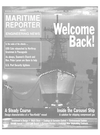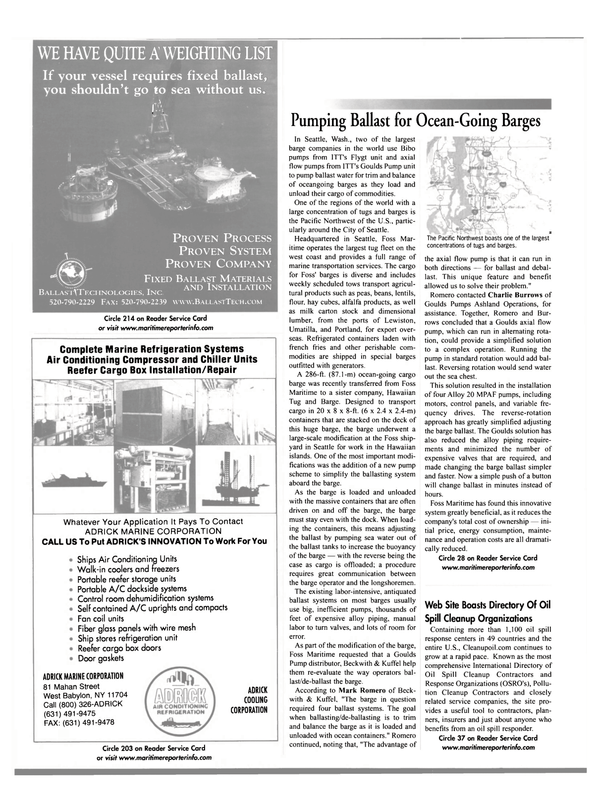
CMP Packs Decade of Tin-Free Experience
The International Maritime Authority has proposed a worldwide ban on tri- butyl tin (TBT) based antifouling paints, starting in January 2003. Confirmation of these dates is expected at the IMO diplomatic conference this October.
Although some ship operators have already converted to tin-free antifoul ings, most ship operators are waiting until the ban is confirmed before they decide a policy on the use of tin-free antifoulings. This is due to cost and performance considerations. It is clear that most ship operators are not informed about the available tin-free technologies and are not aware that there are products, which are equal in performance to TBT-based antifoulings.
Considerable experience with tin-free antifoulings is found in Japan, as the Japanese were first to ban the application of TBT antifoulings in 1992. Thus, much development work on alternatives has come from Japanese based marine paint companies, such as Chugoku Marine Paints, Ltd. Chugoku Marine Paints has experience in new generation tin-free antifoulings, mainly due to its 50 percent market share in its home country of Japan. CMP has now coated more than 8,000 vessels with their tinfree technology.
There are four mainstream tin-free technologies available and Chugoku Marine Paints are unique in providing all four technologies. This allows unbiased advice to be given to ship operators.
Dry-docking specifications can be made up of a combination of the technologies below to produce the ideal price/performance combination.
Third Generation Tin-Free Antifoulings — Sea Grandprix 1000 (Sea Grandprix 2000 for coastal ships): Based on patented Organo-Silyl Acrylate resins, this technology offers the highest antifouling performance available.
Benefits include: • Equivalent performance to high strength TBT based antifouling • Highest in-service performance and lowest risk of fouling - suitable for ship trades and trading areas with a high risk of fouling • Up-to five-years between dry-dockings • Large track record of more than 500 full ship applications • Self-polishing and self-smoothing to minimize fuel consumption • Chemically very similar to TBT-based antifoulings Typical uses are on trades with a high fouling risk such as LNG and VLCCs trading in the Persian Gulf, cruise ships, short sea and coastal vessels operating in the Mediterranean and Caribbean.
Second Generation Tin-Free Antifouling - Sea Grandprix 500 (Sea Grandprix 700 for coastal ships) Based on Metallic Acrylate resin, this technology offers good performance to most deep sea and coastal vessels. Benefits include: • Equivalent performance to medium strength TBT based antifouling • Three- to five-years between dry-dockings, dependent on trade • Large, successful track record of more than 2,000 full ship applications • Self-polishing and self-smoothing to minimize fuel consumption • Can be applied direct to all other antifoulings • Chemically similar to TBT-based antifoulings Typical uses are on bulk and tanker trades, ferries, RoRos and car carriers.
First Generation Tin-Free Antifouling - TFA10 and Seatender Series This original self-polishing, tin-free technology is widely used and developed developed during the 1980's. Also called ablative, eroding or controlled depletion, the polishing mechanism in seawater is not as controlled as for second and third generation antifoulings. Benefits include: • Relatively low cost • Large track record at new building and repair — more than 5,000 full ship applications • Up to three years between dry-dockings • High volume solids to reduce solvent emissions • Can be applied direct to all existing antifoulings • Typical uses are on bulk trades, ferries, RoRos and car carriers.
Biocide-Free Systems Sea Grandprix Eco-Speed products are proven copper and biocide-free systems.
A non-toxic (biocide-free), fouling control system is important to certain high profile industries, such as navy's and environmental agencies. Containership and cruise ship operators are also interested in this technology due to potential fuel savings during five-year dry-docking cycles.
The coating employs special silicone rubber coatings present such a slippery, non-stick surface that fouling does not adhere well to the surface. Any fouling is easy to remove and normally these systems are self-cleaning. When water passes over the surface, the fouling is literally pushed off. So they are not antifoulings, they are foul release systems.
Two versions are available for use on ships: First Generation for deep sea and fast coastal vessels — Sea Grandprix Eco-Speed; and second Generation for slow coastal and low activity vessels — Sea Grandprix Eco-Speed C Benefits include: • Biocide-free and environmentally friendly • Up to five-years between dry-dockings • Slippery and ultra-smooth surface for reduced drag and fuel consumption • Low slime build up and self-cleaning from 10 knots Circle 1 8 8 o n Reader Service Card www. maritimereporterinfo. com
Read CMP Packs Decade of Tin-Free Experience in Pdf, Flash or Html5 edition of October 2001 Maritime Reporter
Other stories from October 2001 issue
Content
- Gratingless Air Circ System in Reefer Ships page: 44A
- New Technology To Debut At Europort page: 44B
- AIS: T h e Future is N ow page: 44F
- NOL Reports First Half Profit of $1M page: 4
- Speechless page: 6
- John Deere Offers N ew 3 0 0 HP Engine page: 7
- Now the Carousel Ship page: 8
- Port Security Strengthened in Wake of Disaster page: 12
- A Race With A Meaning ... Before the Fall of the Towers page: 14
- SCI: Disaster Relief on the Fly page: 15
- Following Wake of Terrorist Attacks, USS Cole is Relaunched page: 18
- INTERTANKO Offers Support, Vital Information During National Tragedy page: 19
- G O M Softness Drives GLM Score Down page: 20
- All-Purpose Aid And Hospital Vessel Delivered page: 21
- ASRY's Services Are In High Demand page: 23
- Rolf To The Rescue: German Yard Delivers Aluminum Rescue Launch page: 25
- Fusion Polycraft's RIB Designed To Be Indestructible page: 25
- Sea-Kindly: A Steady Vessel by Design page: 26
- New Inland Containership Concept Unveiled page: 30
- High-Tech Service Initiatives From Deltamarin page: 32
- FORAN v50: A Technological Renovation page: 36
- N a p a O y Opens Office In Japan page: 38
- NUPAS-Cadmatic Offers V4.3 page: 40
- Ship Evac Simulation Software Shows Promise page: 42
- Wartsila s Dual-Fuel Engine Power Module For FPSO Upgrade page: 44
- Euroferrys' Fast Ferry Features Cat 3618 Power page: 46
- PRI Fuel Treatment Helps Meet Emissions Challeng es page: 47
- Western Towboat Gets A N e w Titan page: 48
- Nichols Bros. To Construct Powerful Fireboat page: 50
- Statoil Ships Run on Gas... Liquefied Natural Gas That Is page: 51
- W Q I S Broadens Coverage To Meet State Requirements page: 52
- Wartsila Wins Environmental Award page: 53
- Pumping Ballast for Ocean-Going Barges page: 54
- Self-Cleaning Filter System Cuts Maintenance Costs page: 60
- CMP Packs Decade of Tin-Free Experience page: 62
- MarineLine Boosts C l e a r w a t e r ' s Profitability page: 64
- Dampney Manufactures Advanced Coatings page: 67
- W a r t s i l a Engines To Power Queen M a r y 2 page: 70
- Keppel Hitachi Zosen Delivers Semi-tender Rig page: 73


